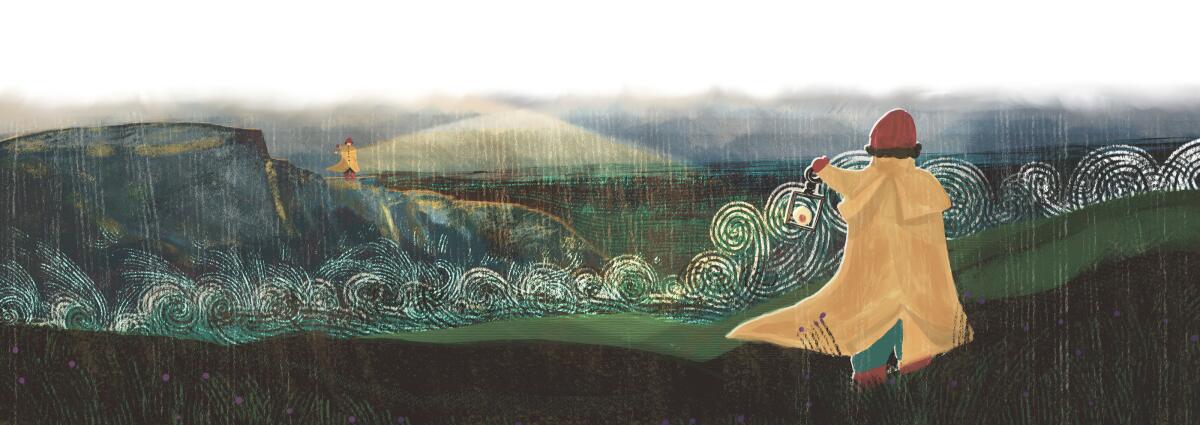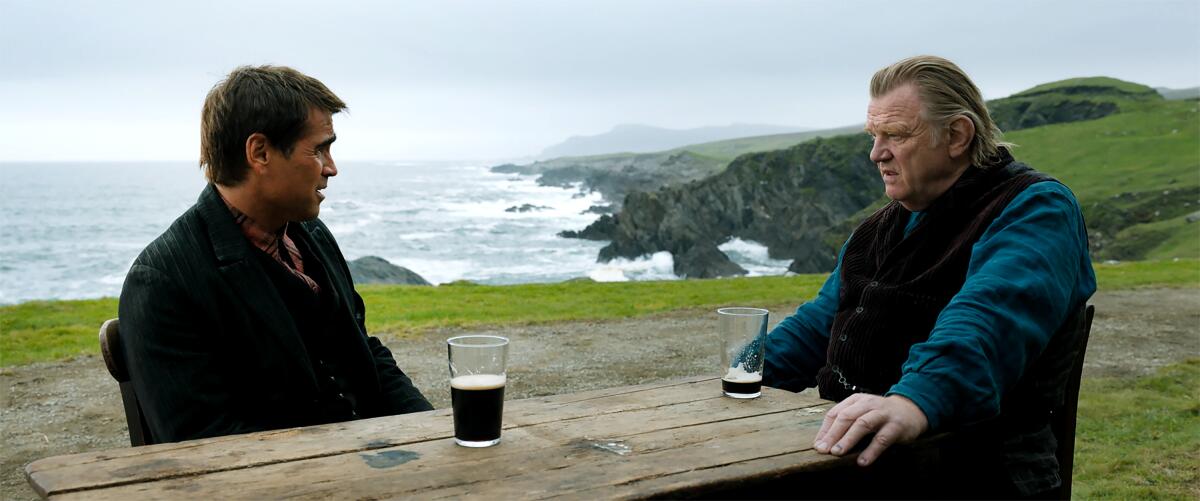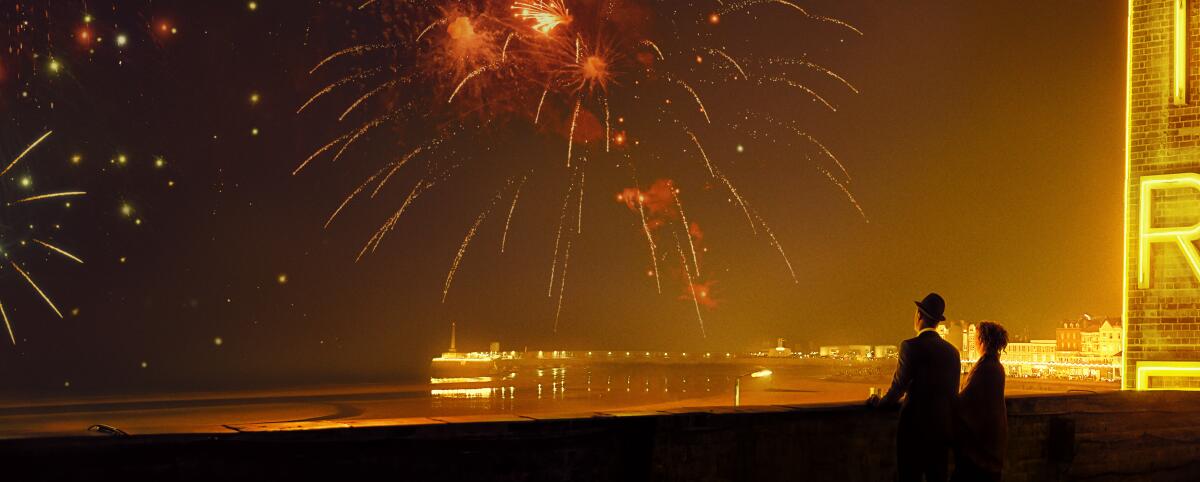How seaside settings evoke turmoil, melancholy and tension

- Share via
In “The Banshees of Inisherin,” set on an Irish island, the gleam of the North Atlantic Sea is visible in nearly every shot. That was purposeful for writer and director Martin McDonagh, whose film centers on two old friends set against each other when one suddenly decides to end their friendship.
“Part of it was the claustrophobia of being on an island — a breakup happens and you can’t actually physically get away from the person you’re breaking up with was a large part of the drama of the story,” McDonagh notes. “You’re going to have to pass this person every day, you’re going to have to see them in the same park or the same church every day. That claustrophobia was a big part of it. But also to capture the beauty of the west coast of Ireland was a major factor in the storytelling.”
To create the fictional island of Inisherin, production designer Mark Tildesley found locations on Inishmore, part of the Aran Islands, and Achill Island. The majority of the sets were built, and everything had to be brought in by ferry from the film’s base in Galway. Ireland’s tempestuous weather was also a factor, but that sense of an uncontrollable environment played into the tone of the film itself.
“‘Banshees’ is really about that wild turmoil going on,” Tildesley says. “It’s that sad need to be at war with each other. You would never go to the Aran Islands to make a film — no sensible person would ever go there. But Martin had been there as a young man, and it’s where he set some of his early plays. The attraction was that it was so wild and it would add something extraordinary to the turmoil that was going on between these two characters.”

Shortly after filming “The Banshees of Inisherin” last summer and early fall, Tildesley moved on to another coastal location, Margate, for Sam Mendes’ “Empire of Light.” That film, set in the early 1980s, centers on a cinema called the Empire and embraces the run-down, melancholy feeling of English seaside towns. Initially, the production looked at Brighton, but Margate embodied the time warped sensibility that Mendes wanted. Tildesley and his team reimagined Dreamland Cinema, a former working movie theater on Margate Beach, and primarily used real locations because cinematographer Roger Deakins wanted to capture the existing light.
“We put ourselves in a difficult position, because we chose to use this cinema, which we renamed the Empire, and we gave it a face-lift, because it’s actually derelict and not in use,” Tildesley recalls. “It was a beautiful building, but it’s crumbling, which was really great for us in some sense, because we wanted to have that feeling. Showing the Old World cinema, the glory years and good times gone by, and what it used to be. It was also a challenge to shoot on the seafront in winter.”
“Empire of Light” stars Olivia Colman as the cinema’s duty manager, Hilary, a woman grappling with mental health issues. The film, which was primarily shot chronologically, uses the setting to help convey Hilary’s state of mind. It helped that Margate, like many English seaside towns, is in a state of disrepair despite its storied Victorian history.
“That sense of decay is apparent,” Tildesley says. “Hilary, our character, struggles with her mental illness and has these spates of being fine one moment and lost the next. So in a way, this town and this cinema and that decay was really reflected in her character.”
Whereas “Empire of Light” ultimately opted not to shoot in Brighton, Michael Grandage’s “My Policeman” did use the south coast for many of its scenes. The film, set between the 1950s and present day, re-created period Brighton and London largely on location. Production designer Maria Djurkovic looked at numerous references to get the aesthetic tone right, drawing on Edward Bawden’s 1958 linocut of Brighton Pier.

“That was so evocative of the atmosphere, the mood and the colors for this piece,” Djurkovic says. “I was carrying this image in my head. It led me into the color palette for the whole movie.”
In the modern-day narrative, the characters reflect on past regrets, which is amplified by their isolated, seaside house. Production used a real home in Peacehaven, adjacent to the iconic white chalk cliffs and the turbulent English Channel.
“One of the photographs we had on our mood board was the house that we ended up shooting in,” Djurkovic notes. “The houses all line the seafront, and then there are the cliffs down to the ocean, and we trolled backwards and forwards and backwards and forwards. Peacehaven was very good in terms of mood and atmosphere. There’s a really melancholic feel about that place, and we used it for that.”
A similar sense of regret and melancholy underlines Oliver Hermanus’ “Living,” which set one of its key emotional moments in Bournemouth. After the film’s protagonist, Mr. Williams (Bill Nighy), discovers he is dying, the character takes a train from London to the coast, where he attempts to reconcile his stoic life with a desire for adventure. Although the scenes in Bournemouth are relatively short, they reveal Williams’ mournful state of mind, as well as his ill-fated attempt to break free from the tedium of the city.
“God’s Creatures,” directed by Saela Davis and Anna Rose Holmer and set in a remote fishing village, used the Irish seaside for an even more intense atmosphere that plays into the darkness of the story line. The film, about a mother going to great lengths to protect her son, required an actual fish processing warehouse and oyster beds, which the filmmakers found on the coast of County Donegal.
“Proximity to water was very, very important to us,” Holmer says. “Not only in the visual storytelling that we wanted to put on screen, but in the psychology for the characters. The sea is a constant. The weather, the exposure to the wind — that shapes the people and their psychology very much. We see the sea as a character in our film. There’s almost a mythical quality to old landscapes. And there’s a severity. You don’t have to force a gothic tone on top of it — it’s present. These massive cliffs, these massive waves, these massive vistas. Human life is quite small in the scale of the landscapes that we were looking at.”
Although the coasts of England and Ireland can evoke a moody sensibility, they can also convey a more optimistic feeling. In the final scene of “The Banshees of Inisherin,” the two lead characters stand on a beach overlooking the water.
“It was set on that beach there in the hopes that there would be cinematic quality to it,” McDonagh says. “But we got such amazing lights and weather that day. The sun broke through these dark stormy clouds. You wonder, cinematically, ‘Is the hope of the sun breaking through the clouds part of what’s happening at the end? Or are the gray clouds going to be what the end of the movie’s about and there isn’t any hope?’ I feel like there is [hope], and I think that the weather and the location helped with that.”
More to Read
From the Oscars to the Emmys.
Get the Envelope newsletter for exclusive awards season coverage, behind-the-scenes stories from the Envelope podcast and columnist Glenn Whipp’s must-read analysis.
You may occasionally receive promotional content from the Los Angeles Times.








